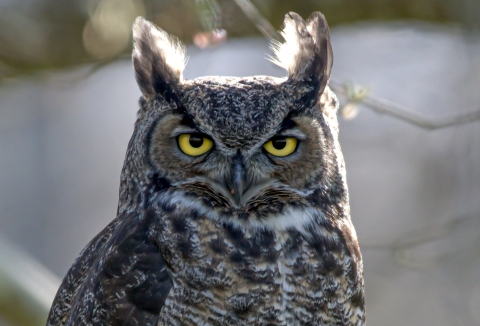Visit Us
Lewis and Clark National Wildlife Refuge includes approximately 20 islands stretching over 27 miles of the Columbia River, from the mouth at the Pacific Ocean all the way upstream near Skamakowa, WA. Lewis and Clark NWR is only accessible by boat. Although seldom visited by humans, people are still following today in famed explorers Lewis and Clark's footsteps (or paddles!) and discovering this little-known refuge. Regulation of recreation activities, such as day-use hours, hiking, and hunting regulations allow for public enjoyment of the refuge while still protecting the wildlife and habitats.
Location and Contact Information
About Us
The Lewis and Clark National Wildlife Refuge was established in 1972 to preserve the vital fish and wildlife habitat of the Columbia River Estuary. Riverine islands here range from tidal sand flats and marshes to forested swamps and upland pasture. This combination supports large numbers of waterfowl, gulls, terns, wading birds, shorebirds, and a surprising variety of raptors and songbirds.
What We Do
Lewis and Clark National Wildlife Refuge aims to maintain biological integrity, diversity and environmental health for the refuge habitats and wildlife, as well as for the greater Columbia River Estuary. Much of this management work involves maintaining, enhancing or restoring habitat. In order to successfully do this work, the Refuge works with a variety of partners, from fellow federal agencies to local non-profit organizations.
Our Organization
Our Species
Hundreds of plant and animal species use the diverse habitats protected by Lewis and Clark National Wildlife Refuge, including a number of threatened and endangered species. There are many resident species that live here year-round, as well as migratory species that stop to utilize the habitats for a various lengths of time. Each season provides an opportunity to observe new wildlife species.
Get Involved
Volunteers are an integral part of what we do. There are a variety of volunteer opportunities available for people of all ages, backgrounds, and skillsets at our sites: Willapa National Wildlife Refuge and Julia Butler Hansen Refuge.
Projects and Research
Lewis and Clark National Wildlife Refuge conducts high-priority inventory and monitoring activities as well as research, assessments, and studies to enhance endangered and threatened species protection and recovery as well as habitat management and restoration activities. The gathering of scientific information assists in evaluating resource management and public use activities to facilitate adaptive management and contribute to the enhancement, protection, use, preservation and management of wildlife populations and their habitats on and off refuge lands.


